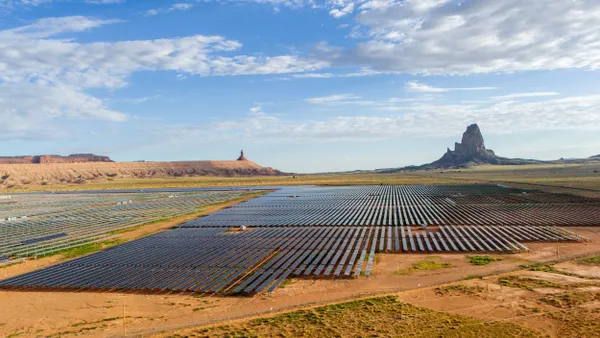Dive Brief:
- Trump administration officials are planning to replace the Clean Power Plan with a narrower set of regulations aimed at thermal efficiency improvements at coal-fired power plants, S&P Global Market Intelligence reports.
- The new rules would require only plant upgrades that can be made "inside the fence" of existing power plants, unnamed administration sources told the outlet, unlike the CPP, which compelled plant owners to seek additional emissions abatement from other sources, such as procuring renewables.
- The so-called fenceline provision was a key argument that CPP critics, including the current EPA administrator, used to challenge the regulations in court last year. Environmentalists said they would challenge any rollback of the carbon rules in court.
Dive Insight:
S&P's report that EPA will seek to replace the Clean Power Plan with a less ambitious rule builds on months of speculation on how the Trump administration will handle President Obama's signature climate initiative.
Pruitt drafted a similar "inside the fence" alternative to CPP back in 2014 when he challenged the federal rule as Oklahoma attorney general. The narrower rule would focus on attaining efficiency improvements through better heat rates at coal plants — in other words, only compelling changes that can be applied within the fenceline of an existing power plant.
The Clean Power Plan controversially reached beyond individual plant upgrades, allowing generators that could not meet its emission standards to offset their power with electricity from lower-emitting sources, like renewables. This, generators argued at the D.C. Circuit Court of Appeals, is akin to forcing coal plants to subsidize their competitors or shut down.
The Obama EPA and its allies replied that this "generation shifting" is "business as usual," saying it is how the power sector would have sought to comply with the CPP and other rules anyway. But outside lawyers told Utility Dive after oral arguments that the "beyond the fenceline" provisions nevertheless represented a new, if not expanded, interpretation of the EPA's regulatory power, and that the case was likely to turn on that question.
The Clean Power Plan, finalized in 2015, never went into effect, as the Supreme Court stayed the rule in January 2016 until legal challenges concluded. The D.C. Circuit put a 60-day hold on the case in April, but has made no announcement about it since that timeframe expired June 27.
If the Pruitt EPA does opt to replace the CPP with a less stringent regulation, it could mean the agency will delay or abandon efforts to challenge the 2009 carbon endangerment finding, which compels the EPA to regulate carbon as a public health threat.
Conservative activists are pushing Pruitt to strike out at the finding, but it would be a huge undertaking, requiring the EPA to prove in court that greenhouse gases are not harmful. But the EPA administrator has shown an appetite for the fight before, signing onto a legal challenge to the finding in 2012. A reported review of climate science at the agency could give him a foundation of friendly climate opinions to draw from in a challenge.












